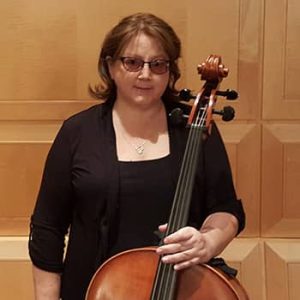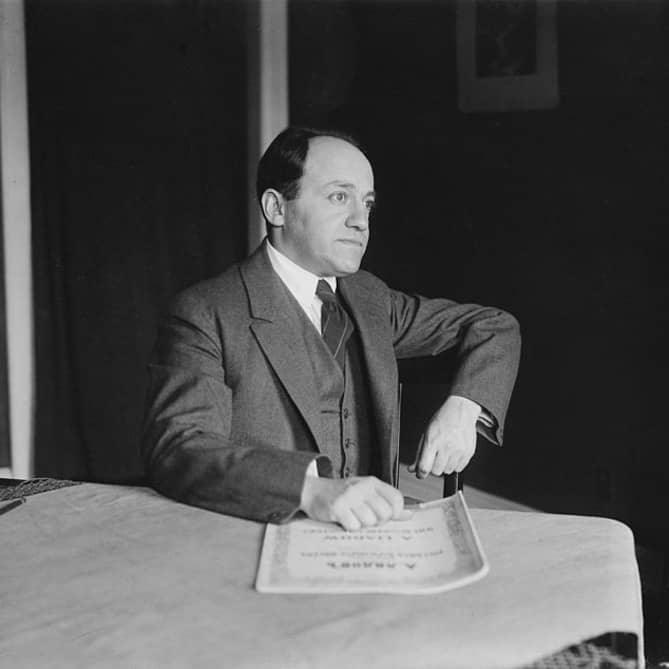
A Brief History and Analysis of Ernest Bloch’s Schelomo
Tracie Price
Introduction
At the tender age of ten, Ernest Bloch wrote a vow that he would become a composer. He then built a mound of stones in the shape of an altar and burned the paper over the stones in ritual fashion. Before age 15, he made good on his vow, having composed both a string quartet and an Oriental Symphony. However, it was with the composition of his epic Schelomo: Rhapsody for Violoncello and Large Orchestra, that he proved to the world that he had indeed become a composer of world class ability. After a performance in November of 1923, the San Francisco Chronicle review affirmed the accomplishment, reporting: “Schelomo is a magnificent work by one of the greatest living composers. Splendid as it is in brilliant coloration, it is not in the vivid pictures that its greatness lies so much, as in the burning sincerity, the richness of passion, the poignant spirituality and the profound penetration into the psychology of a race.” 1
This paper will examine the genesis and composition, as well as provide an analysis of the style, form and content, of one of Ernest Bloch’s greatest masterworks, Schelomo. It will include a discussion of what elements constitute the characteristics of Bloch’s Jewish Cycle and how these characteristics are manifested in the work.
In the 1930’s, Bloch lived in Switzerland and conducted in various European cities, returning to the United States in 1939 due to a desire to retain his U.S. citizenship. He settled in Agate Beach, Oregon, where he lived the remainder of his life. Bloch spent summers teaching at the University of California at Berkeley until his retirement in 1952. In July of 1959, Ernest Bloch succumbed to cancer and passed away.
In 1920, the Italian essayist Guido M. Gatti confirmed the consensus that Bloch’s compositional abilities had indeed reached a pinnacle with the greatest masterwork of this period, Schelomo. In an article on Ernest Bloch for La Critica Musicale, Gatti writes:
- “Bloch has reached the perfection of his music with the Hebrew rhapsody for solo violoncello with orchestra, which bears the name of the great king Schelomo (Solomon). In this, without taking thought for development and formal consistency, without the fetters of a text requiring interpretation, he has given free course to his fancy; the multiplex figure of the founder of the Great Temple lent itself, after setting it upon a loft throne and chiseling its lineaments, to the creation of a phantasmagorical entourage of persons and scenes in rapid and kaleidoscopic succession. The violoncello, with its ample breadth of phrasing, now melodic and with moments of superb lyricism, now declamatory and with robustly dramatic lights and shades, lends itself to a reincarnation of Solomon in all his glory, surrounded by his thousand wives and concubines, with his multitute of slaves and warriors behind him. His voice resounds in the devotional silence, and the sentences of his wisdom sink into the hearts as the seed into a fertile soil: ‘Vanity of vanities, saith the Preacher, all is vanity….” –The orchestra palpitates in all the colors of the rainbow; from the vigorous and transparent orchestration there emerge waves of sound that seem to soar upward in stupendous vortices and fall back in a shower of myriads of iridescent drops. At times the sonorous voice of the violoncello is heard predominant amid a breathless and fateful obscurity throbbing with persistent rhythms; again, it blends in a phantasmagorical paroxysm of polychromatic tones shot through with silvery clangors and frenzies of exultation. And anon one finds oneself in the heart of a dream-world, in an Orient of fancy, where men and women of every race and tongue are holding argument or hurling maledictions; and now and again we hear the mournful accents of the prophetic seer, under the influence of which all bow down and listen reverently…. The violoncello part is of so remarkably convincing and emotional power that it may be set down as a veritable masterpiece; not one passage, not a single beat, is inexpressive; the entire discourse of the soloist, vocal rather than instrumental, seems like musical expression intimately conjoined with the Talmudic prose. The pauses, the repetitions of entire passages, the leaps of a double octave, the chromatic progressions, all find their analogues in the Book of Genesis-in the versicles, in the fairly epigraphic reiteration of the admonitions (‘and all is vanity and vexation of spirit’), in the unexpected shifts from one thought to another, in certain crescendi of emotion that end in explosions of anger or grief uncontrolled.” 4
Even though the title Jewish Cycle has been attached to this period of Bloch’s creative output, Bloch did not generally write music based on specific Jewish melodies but rather as an expression of feelings that he experienced as a result of his Jewish heritage and his study of passages in the Bible. As a result, there has been some controversy over the labeling of Bloch as a “Jewish composer” based on these works. Bloch himself addressed this topic sereral times during his life, saying on one occasion:
- “In my work termed ‘Jewish’ — my Psalms, Schelomo, Israel, Three Jewish Poems, Baal Shem, pieces for the cello, The Sacred Service, The Voice in the Wilderness — I have not approached the problem from without — by employing melodies more or less authentic (frequently borrowed from or under the influence of other nations) or “Oriental” formulae, rhythms or intervals, more or less sacred! No! I have but listened to an inner voice, deep, secret, insistent, ardent, an instinct much more than cold and dry reason, a voice which seemed to come from far beyond myself, far beyond my parents…a voice which surged up in me on reading certain passages in the Bible, Job, Ecclesiastes, the Psalms, the Prophets…. It was this entire Jewish heritage that moved me deeply, and was reborn in my music. To what extent it is Jewish, to what extent it is just Ernest Bloch, of that I know nothing. The future alone will decide.” 5
Exactly what constitutes Jewishness in Bloch’s music has been the source of much speculation, despite statements such as this. In his writing can be found numerous examples of augmented seconds and fourths, which are characteristic of Near-Eastern scales and there are modal tonalities and melismatic melodies that are similar to Hebrew chant, although literal quotations are rare. There are various examples from Bloch’s instrumental works that bear a close resemblance to Jewish song. However, many authorities, such as Alfred Einstein and A.Z. Idelsohn, “feel that Bloch belongs to that group of composers who have recreated their people’s music out of themselves. He is Jewish…in the same sense that Debussy was French, Sibelius Finnish, or Bartôk Hungarian, and in that sense he may be identified with a kind of Hebrew Nationalism.” 6
There are a number of common characteristics evident in the works of Bloch’s Jewish Cycle; these are outlined in Table 1. The employment of many of these techniques as they specifically relate to Schelomo will be discussed in the section on analysis of the work.
Characteristics of Ernest Bloch’s Jewish Cycle Works
Melodic Characteristics
- Many fourths and fifths
- Augmented seconds
- Quarter tones
- Close relationship with Jewish Song
- Melismatic formations
- Irregular phrasing
- Cross relations
- Modal flavor
Rhythmic Characteristics
- Motifs derived from Hebrew language
- “Bloch Rhythm” (Scotch-snap)
- Frequently changing meters/tempo
- Repeated passages feature decreasing note values
- Solo “vocal” lines utilize rhythmic freedom
Harmonic/Textural Characteristics
- Contrapuntal texture
- Parallel fourths and fifths
- Parallel six-four chords
- Unresolved dissonances
- Chords built on fourths and fifths
- Use of simple triads for expressive purposes
- Unison voicing for emphasis
Melodically, Bloch had a knowledge of Synagogical chant and motives of Jewish folk tunes, although, as previously stated, he rarely employed direct quotations from these. His melodies are often constructed with an abundance of fourths, fifths and augmented intervals. He also occasionally employed the use of quarter tones. His use of these intervals was not, as with many of his contemporaries, to explore new tonalities, but simply as a means of expression.
Bloch’s rhythmic patterns often mimic spoken Hebrew. For example, in Hebrew there is a tendency to place the accent towards the last syllable of the word. In his vocal works, he employs frequently changing meters and strong accents in order to be faithful to the texts. When he uses these techniques in instrumental works, he is actually thinking in terms of Jewish song. The frequently appearing “Bloch rhythm” can be derived from many Hebrew words such as “Le-cho (sixteenth–dotted eighth) and Shema (thirty-second–dotted eighth).” 7 One expert on Jewish music sees Bloch’s phrases as containing a veering of the climax toward the ending, which he sees as paralleling the linguistic phrase of spoken Hebrew. Often in his instrumental works, Bloch will apply this by writing repeated and sequential motives that decrease in note values until the maximum intensity is reached.
Harmonically, Bloch does not avoid use of traditional harmonies, however, he also does not seem to be bound by rules that would hamper his freedom of expression. His works are replete with unresolved dissonances and parallel fourths and fifths. One of the marks of his brilliance is his use of simple triadic formations when he wishes to make the most profound expression. He often uses simple six-four chords in close position to create an exotic effect. Harmonically Bloch’s music stands as a bridge between the old and the new. He often expressed his belief that music should evolve organically, not through artificial creation. Regarding his compositional techniques he commented: “Art, for me, is an expression, an experience of life, and not a puzzle game — or an icy demonstration of imposed mathematical principles — or dissection in a laboratory. I would add that in not one of my works have I tried to be ‘original’ or ‘modern.’ Theories, like ‘novelty,’ pass so quickly. And what remains? In revenge, my sole desire and single effort has been to remain faithful to my Vision, to the True.” 8
- “Vanity of vanities, all is vanity.
What profit hath man of all his labor
Wherein he laboreth under the sun?
One generation passeth away and another generation cometh;
And the earth abideth forever.
The sun also ariseth,
And the sun goeth down,
And hasteth to his place where he ariseth.
The wind goeth toward the south,
And turneth about unto the north;
It turneth about continually in its circuit.
And the wind returneth again to its circuits.
All the rivers run into the sea,
Yet the sea is not full;
Unto the place whither the rivers go,
thither they go again.
All things toil to weariness:
Man cannot utter it.
The eye is not satisfied with seeing,
Nor the ear filled with hearing.
That which hath been
Is that which shall be,
And that which hath been done
Is that which shall be done;
And there is nothing new under the sun.
(Ecclesiastes 1:2-9)” 9
In 1933, Bloch wrote program notes for a performance of Schelomo by the Augusteo Orchestra of Rome in which he related the circumstances and inspiration that resulted in the composition of the work.
- “This is the story of Schelomo. Towards the end of 1915 I was in Geneva. For years I had been sketching a musical setting of the Book of Ecclesiastes, but neither French, German, nor English suited my purpose and I did not know enough Hebrew. Consequently the sketches accumulated-and slept. One day I met the cellist Alexander Barjansky and his wife. I heard Barjansky play and immediately became his friend. I played him my manuscript works-the Jewish Poems, the Israel Symphony, and the Psalms — all of which were then unpublished and had failed to arouse anyone’s interest. The Barjanskys were profoundly moved. While I played, Mme. Barjansky, who had borrowed a pencil and a piece of paper, sketched a little statue — her ‘sculptural thanks,’ as she put it. At last, in my terrible loneliness, I had found true, warm friends. My hopes revived and I began to think about writing a work for that marvelous cellist. Why not use my Ecclesiastes material, but instead of a human voice, limited by a text, employ an infinitely grander and more profound voice that could speak all languages — that of his violoncello? I took up my sketches , and without plan or program, almost without knowing where I was headed, I worked for days on my rhapsody. As each section was completed, I copied the solo part and Barjansky studied it. At the same time Mme. Barjansky worked on the statuette intended as a gift for me. She had first thought of sculpting a Christ, but later decided on a King Solomon. We both finished at about the same time. In a few weeks my Ecclesiastes was completed, and since the legend attributes this book to King Solomon, I gave it the title Schelomo.
- “As will be seen, I had no descriptive intentions. I was saturated with the Biblical text and, above all, with the misery of the world, for which I have always had so much compassion.” 10
As much as Bloch asserted that the work had no definite program, he did follow the above statement with a commentary he called a “psychoanalysis” of the work. He stated that the violoncello is the voice of Solomon, the rhapsodist of Ecclesiastes, proclaiming the usefulness in all things, while the orchestra “represents the world surrounding him and his experiences of life; at the same time, the orchestra often seems to reflect Solomon’s inward thought while the solo instrument is giving voice to his words.” 11
Schelomo: Basic Structural Outline
First Section- slow tempo, themes:
Example 1a



Example 2

The full orchestra enters at the andante moderato following the cello cadenza with themes that have just been presented. Here can be found examples of Bloch’s use of parallel six-four chords in the celeste, harp, and three soli violins, enhancing the viola melody with an even more exotic atmosphere. The cello takes up this theme and alters it considerably against a tambourine figure that foreshadows the theme from the second major section of the rhapsody. The woodwinds then take up Theme One in parallel fourths while the strings adopt the rhythmic tambourine figure. This section excellently demonstrates one of Bloch’s most colorful devices. It is a kind of organum-passages of parallel octaves containing the bare fifth and fourth, which Bloch often adapts in his works either as an integral part of thematic material or its development, or as accompanying counterpoint. In this section he uses it in both respects, with the main theme in the woodwinds, and accompanimental figures in the strings, harp and flutes also using open fifths. Bloch’s characteristic “Scotch-snap” rhythm, a melodic sixteenth and dotted eighth note figure, is introduced two bars later by the cello and English horn in unison. Bloch then takes the melodic material presented thus far and breaks it into smaller and smaller units and develops it, played by sections of the orchestra against rhapsodic passages of scales and arpeggiated figures in the solo cello. The orchestra answers the increasingly emphatic cello with a thickly orchestrated statement of the viola melody from the beginning of the andante moderato which features parallel fourths, flourishing scalar passages, col legno effects in the strings, diminishing note values for emphasis, and bold brass statements. The agitated orchestra calms again as the cello ascends out of the din to restate the opening cadenza of the rhapsody in an altered form against a sparse string accompaniment. Other instruments join in with fragments of the various themes as the cello continues and increases in volume and tempo. All this activity comes to a dramatic halt with the cello freely making an impassioned plea against the shimmering tremolo of the strings and flutes, culminating in yet another cadenza-like passage which ends with a dramatic upward leap of a minor ninth followed by a two octave downward jump to a fermata, where the intensity is finally allowed to relax. The texture starts thinly with a sparse viola accompaniment, and gradually begins to thicken as more and more instruments join in and add intensity to the increasing tempo. The cello finishes with a statement of the second part of Theme One (Example 1b) as the orchestra takes over, bringing the music to a wild climax of complex layerings of themes, rhythmic figures, and exotic orchestration. There are fanfares of parallel fifths, octave doublings, decreasing note values on repeated material, and changing meters and tempi. This section ends with a dramatic statement of the material from the last cello cadenza by flutes, oboe, clarinet, and violins, supported by a powerful unison accompaniment in the low winds, low brass and low strings, and pulsating sixteenth notes in the horns. Particularly interesting is a line of ascending quarter notes in parallel diminished seventh chords by the low winds, brass and strings, during the climactic statement of the passage. The orchestral climax finishes with four bars of parallel fifths leading into four bars that are marked Quasi una Cadenza (ma in tempo), which are a wild collage of thirty-second note and sixteenth note flourishes. This orchestra cadenza leads directly into yet another solo cello cadenza, this one being restatement of the cello cadenza material from Example 1c, which now provides the bridge to the second section of the rhapsody.
“Theme Two (Example 2) at allegro moderato is announced by the bassoon playing the rhythmic figure heard earlier in part one, this time against a rustling of tremulant violins on the bare fifth E-B.” 13 The theme is stated in its entirety a few bars later by the oboe. This theme consists of a rhythmic melody of seven measures followed by a pi� animato passage of diatonically moving quarter and half notes. This theme is also the only genuine Jewish melody used in the rhapsody. It is based on a South German Jewish melody, Kodosh Attoh (Holy art Thou) that Bloch remembers being sung to him by his father when he was young. Immediately following the oboe, the cello repeats the second cadenza of Theme One (Example 1b), and at the same time, Theme Two is played against it in parallel fourths as a counter melody in the woodwinds. The solo cello only states the militaristic second theme a single time during the entire rhapsody, which is significant when one considers Bloch’s regular use of the various themes as motivic building blocks. After the cello states this theme, which is quite agitated and played a step lower than that of the oboe, it embarks upon a lengthy restatement of the opening cadenza theme (1a). This section is remarkable in that the orchestra develops the rhythmic second theme as if preparing for war, while the voice of Solomon freely laments over the top of all that is happening. The cello writing is rhythmically indefinite, often notated with eighth note quintuplets against the driving rhythms below.
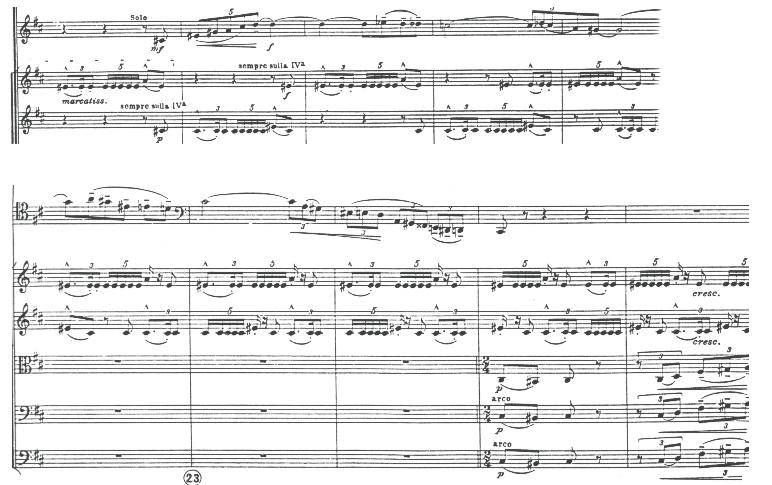
The third part of the composition is marked andante moderato and does not employ any new thematic material. However, it does cast a new light on the previously introduced material. From the outset, there is a remnant of the martial second theme, now played softly by timpani underneath a tremolo and open fifths in the strings. The solo cello writing in this section is extremely somber and it is here that Bloch employs a single quarter tone in his writing:
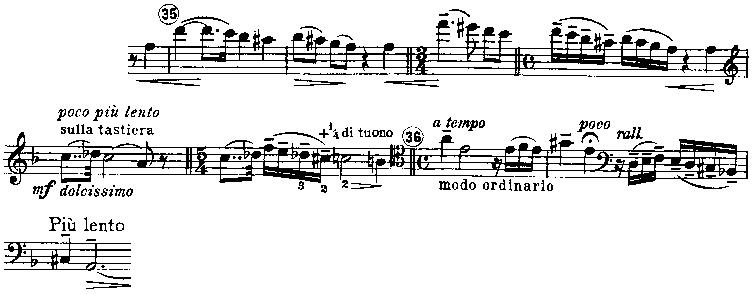
The orchestra enters peacefully with a shimmering sixteenth-note accompaniment supporting a dolce statement of the melody from the first section that seems to draw the lamenting Solomon out of his hopeless state into a more dreamlike world. The second theme can still be heard in the distance in the oboe, but overall there is an air of peace. The cello seems to be off in its own private world, dreaming of better things as it ascends into the stratosphere of its range in an irregular rhythm.
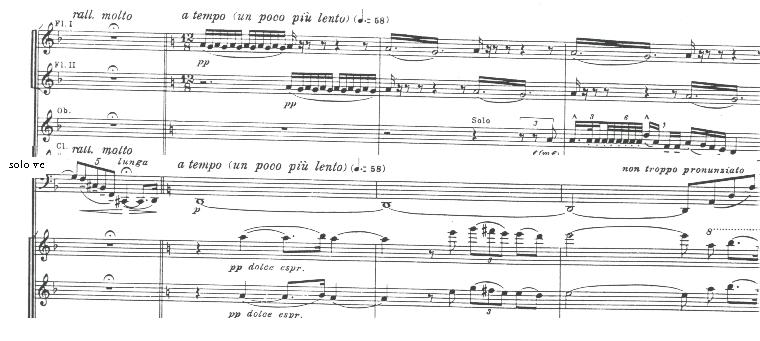
[2] Henrichs, William Lee. “The Music of Ernest Bloch: A Critical Survey.” Master’s Thesis, Texas Christian University, 1958.
[3] Ibid.
[4] Gatti, Guido M. “Ernest Bloch.” The Musical Quarterly 7, no. 1 (January 1921): 20-38.
[5] Henrichs, William Lee. “The Music of Ernest Bloch: . . .”
[6] Ibid.
[7] Ibid.
[8] Ibid.
[9] Soltes, Avraham. Off the Willows: The Rebirth of Modern Jewish Music. New York: Bloch Publishing Company, 1970.
[10] San Francisco Symphony Orchestra Program Notes. 1955-56
[11] Ibid.
[12] Henrichs, William Lee. “The Music of Ernest Bloch: . . .”
[13] Ibid.
[14] Ibid.
[15] Gilman, Lawrence. Philharmonic Symphony Orchestra Program Notes. October 1954-May 1957.
Subjects: Historical
